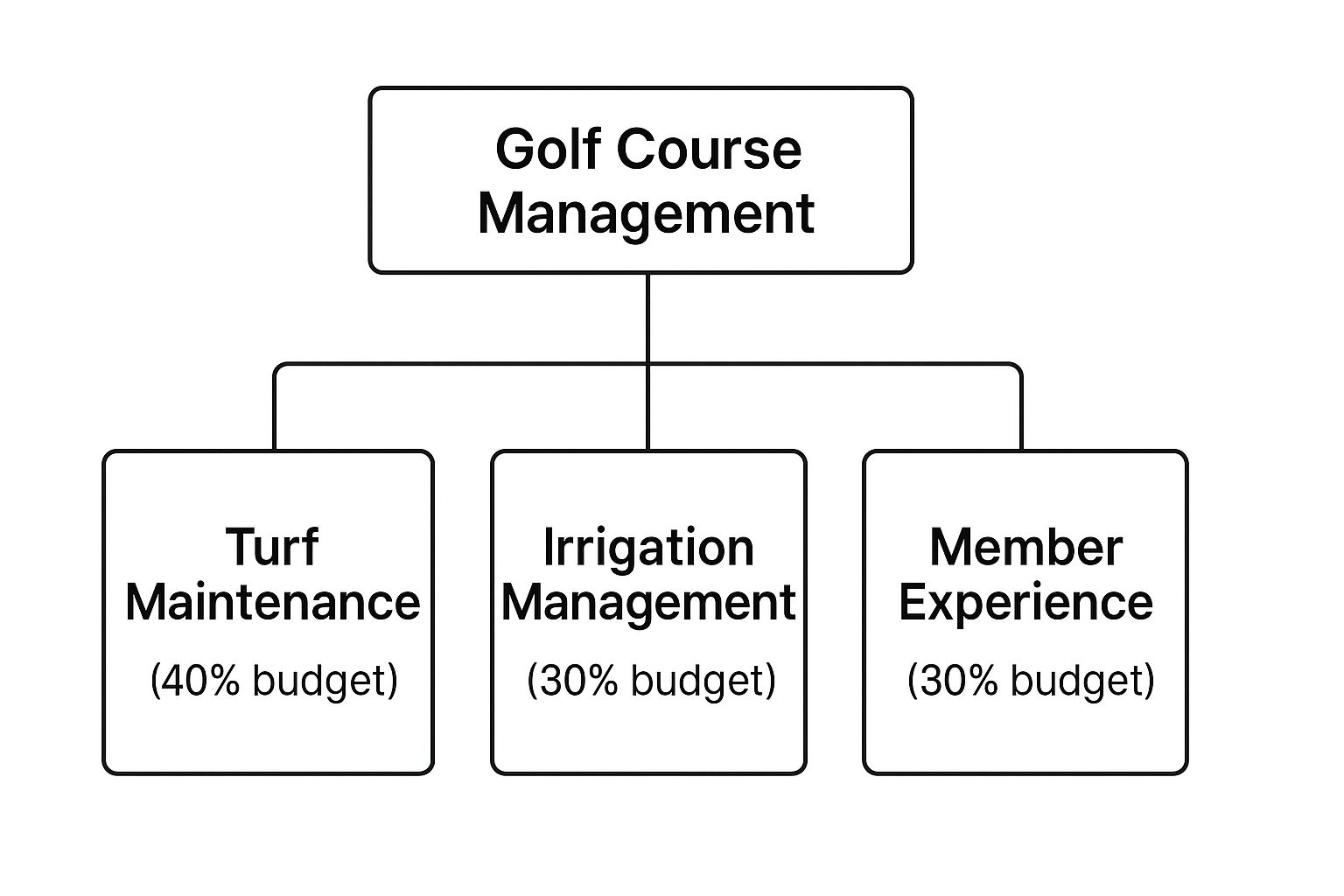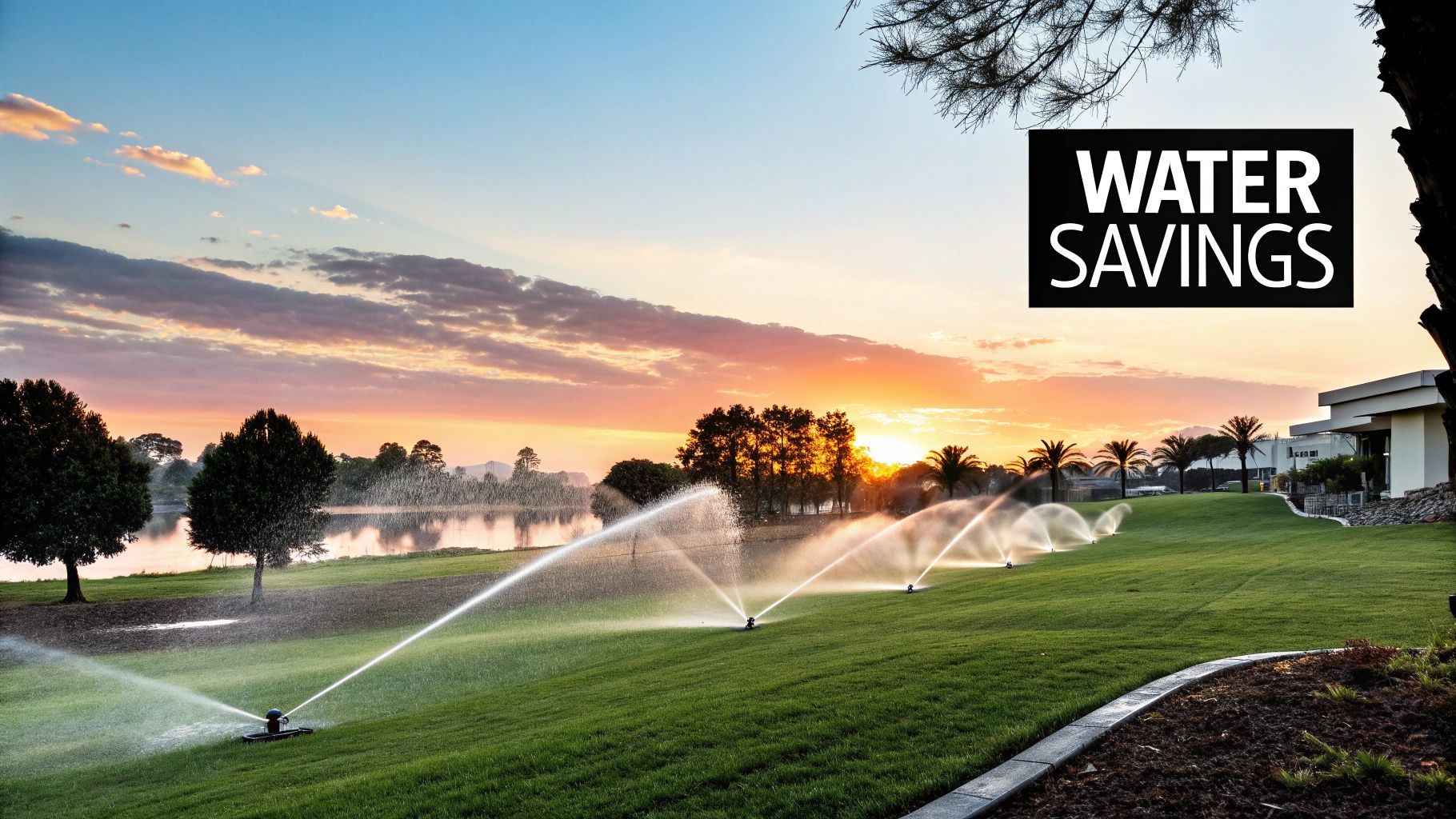Excellent golf course management is a delicate dance, a constant balancing act between keeping the books healthy, the members happy, and the turf thriving. It’s about weaving smart, day-to-day operational tactics into a long-term vision that builds a sustainable and successful club. This approach ensures your course isn't just a beautiful place to play, but a robust business that stands the test of time.
The Blueprint for a Modern Golf Operation
Running a top-tier golf course today is far more than just cutting grass and collecting green fees. It's a sophisticated blend of art and science—crafting an unforgettable experience for every golfer while driving sustainable business growth. This guide is designed to go beyond the basics, diving straight into the actionable strategies that separate the truly thriving clubs from all the rest.
We’ll break down the interconnected pillars of financial planning, member satisfaction, agronomic excellence, and smart technology. Think of this as your playbook for building a resilient operation that not only looks pristine on the outside but performs brilliantly on the balance sheet.
Balancing Budget and Experience
At its core, effective management is about making smart choices with your resources. A huge chunk of any course's operating budget goes toward just a few key areas that directly shape the golfer's experience. Getting a handle on this financial breakdown is the first step toward optimizing your entire operation.
The infographic below gives a great visual of a typical budget breakdown, showing exactly where the money goes.

As you can see, agronomy—everything related to turf and water management—often eats up the largest slice of the pie. This isn't just a cost center; it's a critical investment that underscores its importance to the club's overall success.
A pristine course is your greatest asset. While member experience is the ultimate goal, it is built upon the foundation of outstanding turf and irrigation management. Neglecting these core operational pillars will inevitably impact satisfaction and revenue.
The Growing Business of Golf
This relentless focus on operational excellence is absolutely crucial in today's competitive market. The global golfing market was valued at around USD 20 billion and is on track to hit USD 22 billion by 2033. This growth isn't happening by accident; it's driven by forward-thinking clubs that are upgrading facilities and enhancing golf tourism experiences. You can find more insights on the global golf course market and its growth drivers.
To get a piece of that action, modern clubs have to think like a holistic business, not just a golf course.
Here's a quick look at the core components that make up a modern, comprehensive golf course management strategy. These pillars work together to create a stable and successful operation.
Core Pillars of Modern Golf Course Management
| Pillar | Key Objective | Example Strategy |
|---|---|---|
| Financial Health | Diversify revenue beyond green fees. | Develop robust F&B programs, host corporate events, and optimize pro shop retail. |
| Member Engagement | Build a vibrant and loyal community. | Use personalized communication, host regular social events, and provide superior on-course services. |
| Sustainable Practices | Reduce costs and enhance reputation. | Implement water-saving irrigation systems and adopt environmentally friendly turf care plans. |
| Data-Driven Decisions | Optimize operations and marketing. | Use course management software to track player behavior, manage tee times, and inform strategic choices. |
These pillars aren't just buzzwords; they are the essential building blocks for a modern operation. Nailing these fundamentals sets you up for the specific, real-world tactics we'll cover in the sections ahead.
Driving Revenue Beyond the Green Fees

A healthy financial future for any golf course hinges on much more than just the number of rounds played. While green fees are the lifeblood, the most resilient golf course management strategies focus on building a diverse and robust revenue ecosystem. Relying solely on tee times is a risky game—it leaves your operation vulnerable to weather, seasonality, and the whims of the market.
True growth happens when you start seeing your club not just as a golf course, but as a complete hospitality and entertainment destination. This shift in mindset means unlocking the full potential of every asset you have, from the pro shop to the clubhouse restaurant.
Implementing Dynamic Pricing for Tee Times
One of the most immediate ways to maximize your core revenue is by adopting a dynamic pricing model for your tee times. This approach scraps the old static, one-price-fits-all green fees and instead adjusts rates based on real-time factors. It’s a strategy that the airline and hotel industries have perfected.
Think about these variables:
- Demand: A tee time at 9:00 AM on a Saturday should absolutely command a premium compared to a quiet Tuesday afternoon.
- Time of Day: Early bird and twilight rounds can be priced differently to attract specific types of golfers and fill otherwise empty slots.
- Weather: An automated system can slightly discount rates on a cloudy day to encourage bookings that might otherwise be lost to a shaky forecast.
This model is all about matching the price to the perceived value at any given moment. It ensures you’re never leaving money on the table during peak hours while still attracting budget-conscious players during slower periods.
Transforming Your Clubhouse into a Profit Center
Honestly, the biggest opportunity for substantial growth often lies off the course entirely. Your clubhouse and surrounding facilities are incredibly valuable assets that can generate significant income year-round. It’s time to think beyond just serving the post-round drink and start envisioning your club as a premier local event venue.
Hosting weddings, corporate retreats, and community fundraisers can turn your food and beverage program from a simple amenity into a major profit center. These events do more than just bring in cash; they introduce non-golfers to your property, creating new customers for your restaurant and building powerful brand awareness in the community.
By transforming your facility into a year-round destination, you insulate your business from the unpredictability of the golf season. A successful wedding on a rainy Saturday in November can be just as profitable as a full tee sheet on a sunny day in July.
On top of that, a well-merchandised pro shop is critical. It should be more than just a place to buy balls and gloves; it needs to appeal to both dedicated golfers and casual visitors. Stocking high-margin items like branded apparel, unique gifts, and essential gear turns your shop into a genuine retail destination.
For example, consider products that cater to the growing trend of walking golfers. You can learn more about the 5 best golf push carts to understand what modern players are looking for. By diversifying your offerings like this, you ensure every part of your operation contributes directly to the bottom line.
Crafting an Unforgettable Golfer Experience

In a crowded market, the single most powerful asset your course has is the golfer's experience. Top-tier golf course management strategies aren't just about mowing fairways; they're about creating a sense of loyalty that turns a first-time guest into a lifelong member.
That journey starts with impeccable on-course conditions but certainly doesn't end at the 18th green.
The real goal is to make every single person who steps on your property feel valued. Think about the small things that build a big reputation: the starter who remembers a name, the spotless carts, the perfectly raked bunkers. Every touchpoint is a chance to make a lasting, positive impression.
A smooth round is a happy round. The pace of play is a massive factor in golfer satisfaction, and when it's managed poorly, it leads to frustration that can keep people from coming back. To get this right, you can implement some proven tactics outlined in our detailed guide on golf pace of play guidelines for a faster round.
Building Community Beyond the Course
While a fantastic on-course experience is the foundation, the real magic happens when you build a genuine community. This is how your club stops being just a place to play golf and becomes a central part of your members' social lives. Technology can be a huge help here.
A seamless booking app and personalized email communications are table stakes now. These tools make it easy for members to interact with the club, showing you respect their time. But remember, technology should always support human connection, not replace it.
To really get your members engaged, try a few of these community-building ideas:
- Host More Than Just Tournaments: Think outside the box. Wine-tasting nights, holiday parties, or family-friendly barbecues can bring a much wider range of people to the club.
- Create Clinics and Leagues for Everyone: Offer specialized clinics for beginners, women, or juniors. A fun, low-pressure weekly nine-hole scramble can be a great way to encourage players of all skill levels to participate.
- Recognize Your Members: Did someone get a hole-in-one or win a local tournament? Celebrate it on your social media channels or in the club newsletter. It’s a small gesture that goes a long way.
The most successful clubs understand they are in the hospitality business first and the golf business second. Every interaction, from the pro shop to the restaurant, must be driven by a commitment to proactive, personalized service that anticipates the golfer's needs.
Adapting to a Changing Game
This all-encompassing focus on the total experience is more critical than ever. The game is changing, with a demographic shift bringing more women and younger players to the sport. This has pushed smart course managers to improve their off-course engagement with better membership options, modern training facilities, and user-friendly digital platforms.
Ultimately, a memorable experience is the sum of many small, well-executed parts. It’s the pristine green, the friendly greeting at the bag drop, and the vibrant club culture that keeps players deeply engaged and fiercely loyal for years to come.
5. Champion Sustainable Agronomy
A pristine course is your club's greatest asset, but maintaining that perfect look doesn't have to break the bank or harm the environment. Modern agronomy is all about achieving that balance. This isn’t just some "green" talking point; it's one of the most effective golf course management strategies for long-term financial health and operational resilience.
Sustainable agronomy, done right, means creating phenomenal playing conditions that are also cost-effective and responsible.
It really all starts with getting smarter about water. Irrigation is almost always one of the biggest variable expenses for a course. Thankfully, modern tech gives us powerful ways to cut both consumption and costs. Smart irrigation systems, loaded with soil moisture sensors and weather data integration, make sure you're watering only when and where it's absolutely necessary.
This simple shift prevents the kind of overwatering that leads to turf disease and waste, all while keeping your fairways and greens healthy, even when things get dry.
Adopt Resilient Turf and Smarter Pest Management
Beyond how you water, what you plant makes a massive difference. Introducing drought-resistant turf varieties in key areas—especially in the rough or out-of-play zones—can slash your water needs. These hardy grasses are bred to thrive with less irrigation, which translates directly to lower utility bills and less strain on your maintenance crew.
This approach builds a tougher, more resilient course that can handle whatever the weather throws at it.
At the same time, moving away from a purely chemical-based approach to pest control is critical. Integrated Pest Management (IPM) is a much smarter, more holistic strategy that protects your turf with minimal chemical intervention.
- Cultural Practices: First, you focus on promoting naturally healthy turf through proper mowing, aeration, and fertilization. Healthy grass is naturally more resistant to pests and diseases.
- Biological Controls: Next, you can introduce beneficial insects or organisms that prey on common turf pests. You're basically letting nature do the heavy lifting for you.
- Targeted Chemical Use: When chemicals are absolutely necessary, they're used sparingly and with precision. You’re spot-treating a specific problem area instead of just blanketing the course with preventative applications.
This method doesn't just shrink your chemical budget; it protects local ecosystems and seriously boosts your club’s reputation as a responsible steward of the land.
A sustainable agronomic plan isn't just an environmental initiative; it's a proactive business strategy. It builds a resilient course that is less vulnerable to drought, pest outbreaks, and rising utility costs, ensuring exceptional playing conditions for years to come while strengthening your brand.
By combining water-efficient technology, resilient turfgrass, and intelligent pest control, you create a powerful, self-reinforcing system. This isn't about sacrificing quality for the sake of being "green." It’s about building a robust, long-term agronomic plan that delivers the immaculate conditions golfers expect in a way that is both financially and environmentally sound. This commitment to sustainable excellence is a true hallmark of modern golf course management.
Using Data to Make Smarter Decisions
Gut feelings have a place in golf, but the most effective golf course management strategies aren't built on guesswork. They’re built on a solid foundation of data. Making the shift from intuition to informed decision-making is what separates a good operation from a great one. The right technology gives you a clear roadmap to efficiency, growth, and a golfer experience that keeps people coming back.
Think of modern course management software as the central nervous system for your entire operation. It pulls together systems that used to live on their own islands—like tee sheets, point-of-sale (POS) terminals, and member databases—into one interconnected hub. This integration is where the magic really happens, unlocking insights you never had before.
Uncovering Actionable Insights
With all your data in one place, you can finally start asking smarter questions. Which tee times are always booked solid, and what demographics are filling them? What are your peak hours for pro shop sales, and what’s flying off the shelves? Digging into this information helps you understand player behavior on a much deeper level.
Data tells a story. It might show you that your twilight rates are way underpriced, or that a specific marketing email drove a 20% increase in weekday bookings. These are the kinds of insights that let you make small tweaks that lead to big returns.
This data-first approach empowers you to squeeze every drop of revenue out of your tee sheet, ensuring you maximize every available slot. It also gives you the specific feedback you need to create marketing campaigns that actually resonate with your players, not just the audience you think you have.
On-Course Technology and Its Impact
The benefits of data go way beyond the clubhouse. Technologies that once felt like something out of a sci-fi movie are now becoming essential tools for managing the course itself efficiently.
- GPS Cart Tracking: This gives you real-time data on pace of play, allowing your marshals to step in and fix bottlenecks before they ruin someone's round. It also shows you exactly where carts are going, helping you spot high-traffic areas that might need a break or a path adjustment. For golfers who prefer to walk, understanding popular routes can also shape decisions on equipment rentals, like those covered in this guide to electric golf push carts.
- Soil Moisture Sensors: As we touched on in agronomy, these sensors give you precise data on how thirsty your turf is. This takes the guesswork out of watering, cuts down on water usage, and ensures your maintenance team is putting resources exactly where they’re needed. The result? Healthier turf and lower costs.
By embracing a data-driven culture, you create a feedback loop that constantly refines how you run things. It leads to smarter staffing, more effective resource allocation, and, ultimately, an experience that turns first-time visitors into lifelong members.
Common Golf Course Management Questions

Even with a rock-solid strategy, you're going to run into specific challenges. It just comes with the territory. This section is all about tackling the most common questions I hear from course managers and board members, with practical answers to help you sharpen your operations and solve those nagging problems.
Think of it as a quick-reference guide. These are the hurdles that pop up time and again in the day-to-day grind of running a successful golf facility.
What Are the Most Critical KPIs to Track?
If you want to get a real pulse on your course's performance, you need to look beyond just revenue. A healthy operation is measured by a balanced scorecard of metrics. The best golf course management strategies are always driven by data, not guesswork.
Here are the financial KPIs that really matter:
- Revenue per Available Round (RevPAR): This tells you how well you're actually filling your tee sheet.
- Gross Profit Margin: You need to know this for both your pro shop merchandise and your F&B program.
- Membership Retention and Attrition Rates: These numbers are the ultimate gauge of member loyalty and satisfaction.
But don't stop there. Operational KPIs are just as crucial. You should be tracking total rounds played, average pace of play, and course condition ratings pulled from player surveys. When you combine these with the financials, you get a complete picture of your club's health and your customers' happiness, which is exactly what you need to make smarter decisions.
How Can a Smaller Course Compete with Large Management Companies?
Smaller, independent courses can absolutely win—you just have to play a different game. You can't out-scale the big guys, so you have to out-experience them. Your biggest advantage is the ability to offer a level of personalized service that the corporate chains simply can't match.
Focus on building a strong, tight-knit community. Run exclusive member events, create fun and engaging leagues, and empower your staff to know members by name. In all of your marketing, lean into the unique character, history, and layout of your course. You might not have the same purchasing power, but you can create a superior, bespoke experience that builds the kind of fierce loyalty that money can't buy.
Your unique club culture isn't a weakness; it's your most powerful competitive weapon. Big chains sell a standardized product, but you can offer a genuine sense of belonging that golfers crave.
What Is the First Step in Creating a Sustainable Maintenance Program?
Before you do anything else, you have to conduct a comprehensive audit of your current practices. It’s simple: you can't improve what you don't measure.
Start by getting a baseline for your water usage, chemical inputs, and overall energy consumption. At the same time, get a thorough soil analysis done. This will tell you exactly what your turfgrass needs to thrive.
This initial data is the foundation for setting realistic, achievable reduction goals. Once you have it, you can start prioritizing initiatives like upgrading to water-efficient sprinkler heads, planting native, low-maintenance grasses in out-of-play areas, or developing an integrated pest management plan. My advice? Start with the low-cost, high-impact changes first to build momentum and show your board and members some quick wins.
Ready to make every round less fatiguing and more enjoyable for your walking golfers? Caddie Wheel offers a simple, powerful electric assist for almost any push cart. Learn more about how Caddie Wheel can elevate the golfer experience at your course on caddiewheel.com.


Share:
Your Guide to Golf Carts That Follow You
How to Choose Golf Clubs for Your Game